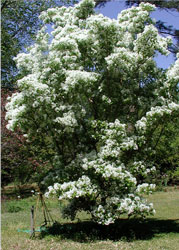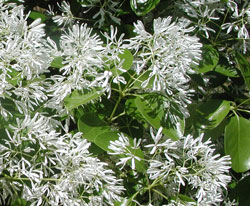Resource Library
Plant of the Week: Fringe Tree
The University of Arkansas System Division of Agriculture does not promote, support or recommend plants featured in "Plant of the Week." Please consult your local Extension office for plants suitable for your region.
Plant of the Week
Fringe Tree
Latin: Chionanthus virginicus

It's easy to be a gardener in the spring because a never ending parade of plants awaken from their slumber and do their thing.
One of the finest of these spring bloomers is the fringe tree (Chionanthus virginicus), a small tree considered by many to be one of our most beautiful native plants. But, beautiful as it is, it remains uncommon in gardens.
Fringe tree, also called Grancy Gray-beard and Old-man's beard, is native throughout the southeastern states but is nowhere abundant. In Arkansas, it occurs in all but the Delta region but is most commonly met in the Ouachitas and southern counties. It blooms as the dogwoods finish and after the trees have leafed out, so it's easy to miss in its wild habitat.
It grows as a multi-stemmed tree or large shrub, usually reaching 15 to 20 feet in height and spread in cultivation. It can reach 30 feet in the wild with a main trunk sometimes 10 inches through, though such specimens are rare.
The snow white fringe tree flowers are produced in loose, terminal 6-inch long panicles that have the ethereal look of puffy white clouds. Each flower on the panicle is four-petaled, strap shaped blooms. Individual plants are dioecious (either male or female), with male plants being more showy because of their longer petals. Like forsythia, the fringe tree belongs to the olive family.
Fringe trees are deciduous with the opposite, 6-inch long, toothless, glossy green leaves appearing as plants bloom. Fringe trees are notoriously slow growing, seldom making more than 6 inches of growth a year.
The absence of this native beauty from our gardens is not for want of trying. It has so far eluded all attempts at commercial scale propagation by cutting and grafting has been problematic because of the need for a good rootstock. Most plants seen in gardens are raised from seed, which require two years to germinate. But, because they' re so slow growing, only native plant specialist nurseries are willing to devote the time needed to produce them.

Fringe tree is considered one our finest native trees in England. It was first sent there by John Bartram (1699 - 1777), the intrepid naturalist from Philadelphia responsible for introducing so many New World plants to England. Bartram farmed on the banks of the Schuylkill River and was a close friend of Benjamin Franklin. The home he built is now a city park and many of his plants still grow in the garden.
Bartram traveled from Canada to Florida in pre-Revolutionary days, collecting plants and seeds as he went. These he sent to a long list of correspondents in Europe, the most important being the woolen draper merchant Peter Collinson (1694 - 1768) who was an avid gardener.
Plant collecting was such a rage amongst the social elite of England that thieves began targeting the better collections. To remedy the problem, Parliament passed legislation making plant thievery a "transportable offense." Ship the hooligans off to Australia - that will teach them.
Though they never met, Bartram and Collinson corresponded for over 30 years and developed a deep friendship. Their letters, resplendent with "thees" and "thous" - for both were Quakers, survive and have been reprinted most recently in the Berleley's book, The Correspondence of John Bartram (University Press of Florida, 1992).
Fringe tree is best in fertile, well drained soil that does not get too dry during the summer. It will grow in light shade, but blooms best in full sun. Because it's slow growing, situate it where it will not be overpowered by nearby shrubbery.
By: Gerald Klingaman, retired
Extension Horticulturist - Ornamentals
Extension News - May 26, 2006
The University of Arkansas System Division of Agriculture does not maintain lists of retail outlets where these plants can be purchased. Please check your local nursery or other retail outlets to ask about the availability of these plants for your growing area.